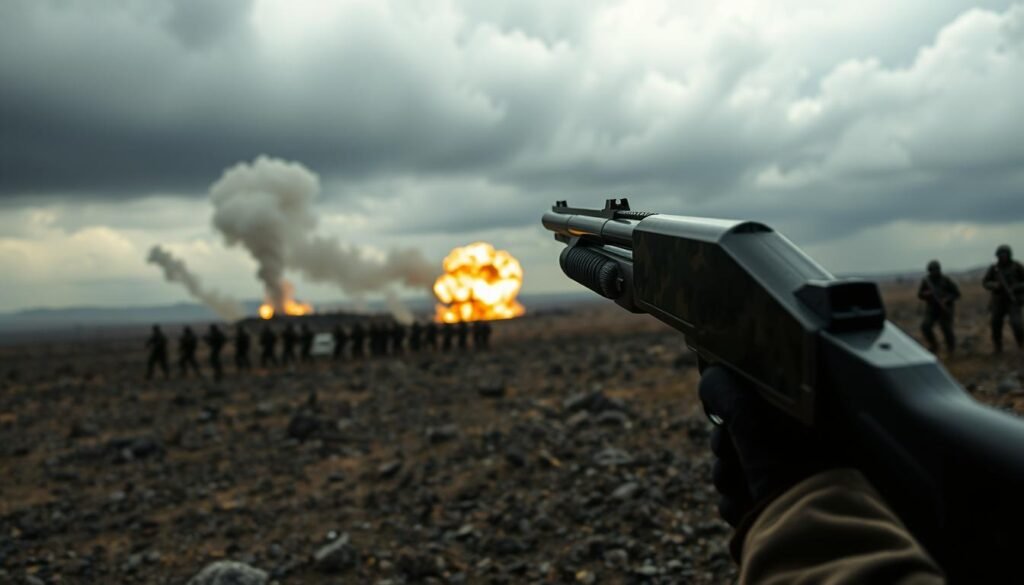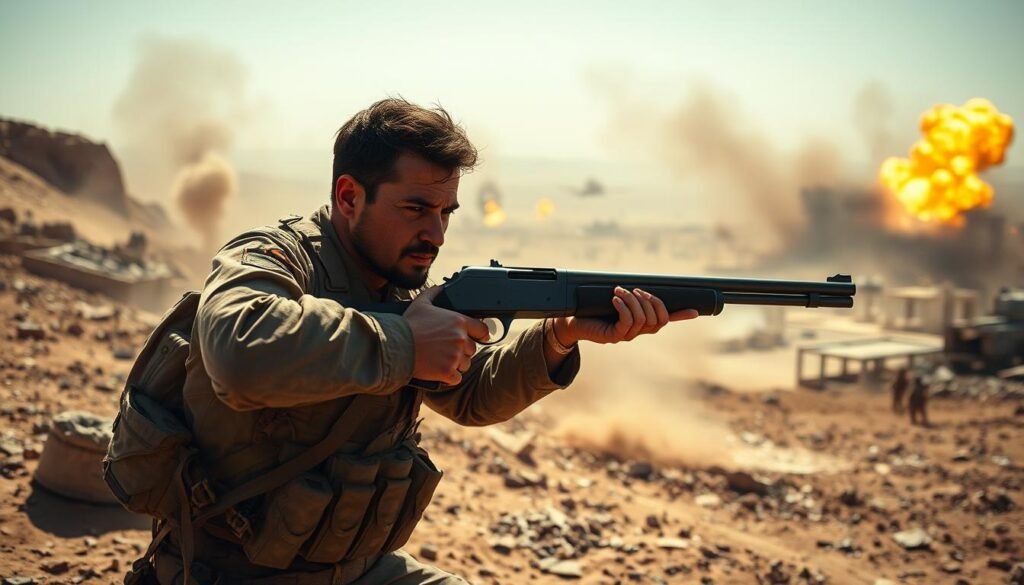Is Using a Shotgun a War Crime? There’s a big debate about using shotguns in war. People wonder if it’s a war crime. Shotguns have been used in many battles, leading to talks about their legal status.
Shotguns in war make us think about modern fighting and its rules. You’ll learn about their history, legal issues, and why they’re a topic of debate.
This article will help you understand the issues with shotguns in war. We’ll look at if using them is considered a war crime.
Contents
- 1 The Historical Context of Shotguns in Warfare
- 2 Is It a War Crime to Use a Shotgun? Legal Analysis
- 3 Technical Characteristics That Sparked Controversy
- 4 Modern Military Use of Shotguns
- 5 Conclusion: Is Using a Shotgun a War Crime?
- 6 FAQ
- 6.1 Are shotguns considered inhumane or excessively cruel in warfare?
- 6.2 What type of ammunition is typically used in combat shotguns?
- 6.3 Have there been any international agreements or declarations banning the use of shotguns in warfare?
- 6.4 How do shotguns compare to other firearms in terms of causing injury?
- 6.5 Are shotguns still used by modern military forces?
- 6.6 What are the rules of engagement regarding shotgun use in combat?
- 6.7 Can the use of shotguns in warfare be considered a war crime under certain circumstances?
The Historical Context of Shotguns in Warfare
Shotguns have been key in modern warfare, from the American Civil War to World War I. They were used in many ways, causing debate and controversy.
American Civil War Applications
Both Union and Confederate forces used shotguns in the American Civil War. They were great in tight spaces, making them valuable on the battlefield.
Colonial Conflicts and Shotgun Deployment
In colonial wars, shotguns were used by colonial forces. They were good against guerrilla fighters. This shows how shotguns fit well in these battles.
During World War I, American trench guns were used in Europe. They were made for fighting in tight spaces. [Is Using a Shotgun a War Crime?]
Germany’s Diplomatic Protest of 1918
In 1918, Germany complained to the U.S. about American trench guns. They said they broke international law. This showed how shotguns were seen as controversial.
Knowing how shotguns were used in war helps us understand today’s debates. The past still shapes talks about military shotguns and international law.
Is It a War Crime to Use a Shotgun? Legal Analysis
Looking into the laws about shotguns in war, you’ll see a lot of rules and agreements. It’s not clear if shotguns are legal in battles. This topic has sparked a lot of debate.
The 1899 and 1907 Declarations
The Hague Declarations of 1899 and 1907 are key to understanding shotguns in war. They banned certain weapons that cause too much pain. Shotguns weren’t mentioned directly, but these rules affect them a lot.
Prohibition on “Unnecessary Suffering”
The idea of “unnecessary suffering” is important when talking about shotguns. Laws say we can’t use weapons that hurt too much. Using expanding ammunition in shotguns can cause a lot of pain.
More rules, like the Geneva Conventions, help clarify weapon use. For example, Protocol I says we can’t use weapons that cause too much harm. These rules don’t ban shotguns but guide their use.
Legal Interpretations of “Superfluous Injury”
Understanding “superfluous injury” is key to knowing if shotguns are legal. Experts say shotguns might not be illegal if used right. But, using certain ammo could be wrong.
Current Legal Status of Combat Shotguns
Today, using shotguns in war isn’t banned by law. But, it depends on how and when they’re used. Here’s a table showing the legal status of shotguns under different laws.
| Legal Provision | Status of Shotguns | Remarks |
|---|---|---|
| Hague Declarations (1899, 1907) | Not explicitly banned | Prohibited expanding bullets |
| Geneva Conventions Additional Protocols | Not directly banned | Prohibited causing unnecessary suffering |
| International Humanitarian Law | Context-dependent legality | Depends on the use and ammunition type |
Precedents and Legal Opinions
Many legal views and cases have shaped our understanding of shotguns in war. Military guides and legal studies give clues on how shotguns are seen by law. They say shotguns are not always illegal, but their use must follow international law.
In summary, using shotguns in war is a complex issue with many laws. To know if it’s a war crime, we need to look closely at the laws and the situation.
Technical Characteristics That Sparked Controversy
Understanding shotguns’ technical features is key to the controversy over their use in war. It’s important to look at the different aspects that make shotguns a topic of debate. This includes the type of ammo used and the injuries they can cause.
Buckshot vs. Slug Ammunition
Shotguns can fire various ammo, like buckshot and slugs. Buckshot spreads out, hitting more targets but causing wider damage. Slug ammunition, however, is a single, large projectile that can deal significant damage to one target.
The choice between buckshot and slugs affects how a shotgun performs in combat. Buckshot can cause multiple injuries over a larger area. Slugs, on the other hand, are more focused.

Military forces have created special shotgun loads for different combat needs. These include frangible rounds that break apart upon hitting, reducing the risk of over-penetration.
Multiple Projectile Injury Patterns
Buckshot’s use can lead to complex injuries due to its multiple projectiles. This can result in more severe and complicated wounds. Treating such injuries can be a significant medical challenge.
Medical and Humanitarian Concerns
The medical and humanitarian impacts of using shotguns, especially with buckshot, are significant. The risk of causing unnecessary suffering or indiscriminate harm is a major concern under international humanitarian law.
Fragmentation Weapons and Explosives
Comparing shotguns to banned weapons like fragmentation devices and explosives shows the controversy. While shotguns are not indiscriminate, their effects can be similar to those of banned weapons.
High-Velocity Rifle Ammunition Effects
High-velocity rifle ammo causes different injuries, often with a smaller entry wound but more severe internal damage. Comparing shotgun wounds to those from high-velocity rifles highlights the unique concerns with shotguns.
When looking at shotguns in modern warfare, consider their technical features. The debate over their use involves technical, legal, and humanitarian aspects.
Modern Military Use of Shotguns
Shotguns have found new roles in modern warfare. They are more versatile than you might think.
The U.S. military now sees the value of shotguns in certain situations. Field manuals have been updated to include them for breaching and crowd control.
These changes come from real-world experience. Military personnel have found shotguns effective in close combat and other roles.
International Military Adoption
Other countries have also started using shotguns in their militaries. Each nation uses them differently, based on their needs.
Some use shotguns mainly for breaching. Others use them in more ways. [Is Using a Shotgun a War Crime?]
Breaching Operations and Non-Lethal Options
Shotguns play a big role in breaching operations. They use special rounds to open doors safely.
They also fire non-lethal rounds like beanbags or tear gas. This makes them useful in many situations.
Close-Quarter Battle Applications
In close combat, shotguns are very effective. They have a lot of stopping power at short distances.
Many special forces use shotguns for this reason.
Rules of Engagement Considerations
Using shotguns in military operations comes with rules. Commanders must think about the risk of damage and if it’s legal under international law.
This requires a deep understanding of combat rules and each situation’s details. [Is Using a Shotgun a War Crime?]
Documented Use in Recent Wars
Shotguns have been used in recent conflicts. They are valuable in urban and counter-insurgency battles.
Reports and analyses often highlight their importance in modern combat.
See Also: Is It a War Crime to Use a Human Shield?
Conclusion: Is Using a Shotgun a War Crime?
You’ve learned about the complex issue of whether using a shotgun is a war crime. Shotguns have been used in many wars, causing debate over their legality.
The law says using shotguns isn’t always a war crime. But, using them against civilians or breaking international law can be a crime.
Shotguns’ wide spread and range add to the debate. Today, military forces still use them for breaching and close combat. [Is Using a Shotgun a War Crime?]
In summary, using shotguns in war is complex. It depends on how and where they are used. Knowing the history, law, and tech of shotguns helps figure out if they’re war crimes.
FAQ
Are shotguns considered inhumane or excessively cruel in warfare?
Shotguns in warfare are debated due to the risk of causing pain. Whether they are seen as cruel depends on the situation and the type of ammunition used.
What type of ammunition is typically used in combat shotguns?
Combat shotguns usually fire buckshot or slugs. Buckshot is more common for its wide spread and effectiveness in tight spaces. [Is Using a Shotgun a War Crime?]
Have there been any international agreements or declarations banning the use of shotguns in warfare?
The Hague Declarations of 1899 and 1907 talked about certain weapons in war. But, there’s no direct ban on shotguns. Their use is judged by the rules of unnecessary suffering and distinction.
How do shotguns compare to other firearms in terms of causing injury?
Shotguns, especially those firing buckshot, can cause many injuries. This has raised concerns among medical and humanitarian groups. The fear is of severe and complex wounds.
Are shotguns still used by modern military forces?
Yes, shotguns are still used by many military forces, including the U.S. military. They are used for tasks like breaching, close-quarters battle, and non-lethal operations.
What are the rules of engagement regarding shotgun use in combat?
The rules for using shotguns in combat differ by country and operation. But, they follow the same principles as other weapons. This includes the rules of distinction and proportionality.
Can the use of shotguns in warfare be considered a war crime under certain circumstances?
Using shotguns could be seen as a war crime if it causes unnecessary suffering. It depends on the situation and how they are used. It must also violate other laws of war.

Vicente Underwood is from New Jersey, USA. He studied law and now works with his senior. In his free time, he writes blogs. Jackson is a proud father of two girls and enjoys balancing his work and family life.




